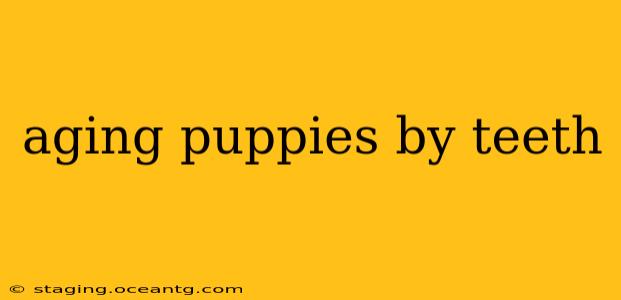Determining a puppy's age accurately is crucial for proper care and development. While veterinary examination is the most reliable method, assessing a puppy's age through its teeth provides a helpful estimate, especially in situations where veterinary access is limited. This guide will delve into the process of aging puppies by teeth, offering a detailed understanding of dental development in canines.
What are the Stages of Puppy Tooth Development?
Puppy teeth erupt in a predictable sequence, providing a roadmap for age estimation. Understanding these stages is paramount to accurate aging. The process generally unfolds as follows:
- Birth to 2 weeks: Puppies are born toothless.
- 2 to 3 weeks: Incisors, the small front teeth, begin to erupt.
- 3 to 4 weeks: Canine teeth (fangs) emerge.
- 4 to 6 weeks: Premolars (cheek teeth) start appearing.
- 6 to 8 weeks: A full set of 28 temporary, or deciduous, teeth is usually present.
- 3 to 4 months: Deciduous teeth begin to loosen and fall out.
- 4 to 6 months: Permanent teeth begin to erupt. This is a gradual process, often overlapping with deciduous tooth loss.
- 6 to 8 months: Most permanent teeth are present, though the last premolars and molars may take longer.
- 6 to 12 months: The complete set of 42 adult teeth is usually fully developed, completing the transition.
How Can I Tell the Difference Between Deciduous and Permanent Teeth?
Deciduous (baby) teeth are smaller and whiter than permanent teeth. They are also more sharply pointed. Permanent teeth are larger, thicker, and have a slightly more yellowish hue. The canine teeth (fangs) are particularly noticeable in their size difference between deciduous and adult versions.
What are the Challenges in Using Teeth to Age Puppies Accurately?
While tooth eruption provides a general guideline, several factors can impact accuracy:
- Breed Variations: Some breeds may experience slightly faster or slower tooth development.
- Nutrition: Proper nutrition plays a role in tooth development. Malnutrition can delay eruption.
- Individual Variation: Like humans, some puppies develop faster than others. There's natural variation within a litter and across breeds.
How Accurate is Aging a Puppy Based on Teeth Alone?
Aging a puppy solely by teeth is an approximation, not an exact science. It's most reliable for puppies under six months old, when the deciduous teeth are present and the eruption of permanent teeth is just beginning. Beyond that age, variations become more pronounced, making accurate age estimation challenging based on teeth alone.
What Other Factors Can Help Estimate a Puppy's Age?
To obtain a more precise estimation, consider combining tooth assessment with other observable characteristics:
- Size and Weight: Compare the puppy's size and weight to breed standards.
- Body Condition: Observe the puppy's overall body condition. Is it lean, overweight, or just right for its apparent age?
- Eye Color: In some breeds, eye color changes with age.
- Coat: Some puppies' coats change in texture or color as they mature.
- Behavior: Puppy behavior patterns shift over time.
Can I use this information without consulting a vet?
While this guide provides helpful information, it is crucial to remember that it’s an estimation, and should not replace a professional veterinary examination. A vet can accurately assess the puppy's overall health, development, and age using a combination of methods.
This information is intended for educational purposes only and should not be considered a substitute for professional veterinary advice. Always consult a veterinarian for any concerns about your puppy's health or development.
